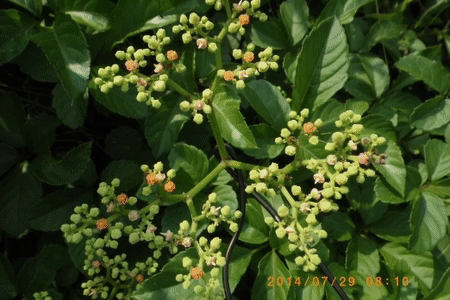Flowers show their true colors A common flower with a unique bidirectional color-changing ability Research news

A plant common to Japan, Causonis japonica, is the first to show a newly discovered trait. Its flowers can change color depending on the stage of its maturation cycle, and then change back to its original color. Although many flowers have been shown to change color depending on their maturation phase, Causonis japonica is the only known example of bidirectional color change. The pigments involved in the colors are related to nutrient-rich colorful vegetables, so understanding the flowers’ color-changing tricks could have downstream applications in improving nutrient yields in certain food crops.
We all like flowers, and one of the most appealing things about flowers is presumably the wide array of shapes, sizes and, of course, colors they come in. But did you know that some flowers can change their colors? Although it’s not all flowers, this trait has been observed in hundreds of different species for at least a number of decades. It’s thought that color-changing flowers do so because it signals to pollinating insects that the flower is ready to supply nectar or pollen which rewards them. This is considered to be an “honest” signal. But the reverse can also be seen; some plants show a “dishonest” signal, with some of their flowers displaying their default color whilst others display their signal color. That behavior is thought to increase the overall visibility of the plant from a distance to would-be pollinators. But whatever the strategy of the plant in question, all examples of color-changing flowers found have been unidirectional: Once the color has changed, it does not change back. So, imagine the surprise University of Tokyo Professor Hirokazu Tsukaya must have felt when he saw a flower of the plant Causonis japonica change color, and then, change again, and again.

Causonis japonica. A magnified image clearly showing the alternating orange and pink colors of the flower petals. ©2022 H. Tsukaya CC-BY
“Even though I’ve studied this plant in detail, having discovered there were at least two varieties back in 2000, the bidirectional color-changing flowers were a completely unexpected finding,” said Tsukaya. “My colleague Professor Nobumitsu Kawakubo from Gifu University is an expert in time-lapse, long-period video recordings of pollinating flowers. He and his student originally tried to explore the pollinating behaviors between the different kinds of Causonis japonica and expected to see the familiar change from its default orange color to bright pink. But they couldn’t believe it when they reviewed the time-lapse video and saw that it not only changed back to orange again, but that this change oscillated between the two states. They informed me on this finding; this compelled us to find out why. So we started a collaboration.”
Thanks to the carefully captured time-lapse videos from the field and detailed observations in the laboratory, Tsukaya managed to connect what physiological changes took place in the flowers concurrent with their changes in colors.
“The initial orange state is coincident with the male stage of the flower’s maturation, when it is secreting nectar,” said Tsukaya. “When the stamen — male part — becomes old and detaches, the flowers turn pink. Mere hours later, the pistil — female part — begins to mature, secretes nectar, and the flower turns orange again. Once that stage is over, the flower fades to pink. The main chemical responsible for the color changing is orange-yellow carotenoid; its cycle of accumulation and degradation is also the fastest known to date. That fact was another surprise to us.”

Time-lapse images. The unique bidirectional color-changing petals were only observed now because in nature, the plant is a chaotic bundle of buds, leaves and flowers that grows quite rapidly. So, it was not really possible to track individual flowers over time. But thanks to carefully controlled time-lapse video recording, now individual flowers can be tracked and hence lead to observations such as this one. © 2022 H. Tsukaya CC-BY
You probably noticed the chemical name carotenoid sounds a little like the word carrot. This is not a coincidence, as the same chemical is what gives typical carrots their orange hue. It’s a good source of vitamin A, and given the color-changing flowers show the most rapid accumulation of carotenoids ever seen, it’s no surprise the researchers think their discovery might have some future application in developing carotenoid-containing vegetables that mature faster or contain higher yields of beneficial vitamins.
“Our next steps will be to find out what is governing the behaviors we have observed,” said Tsukaya. “One big question we have is, at what level are the stages of the cycles regulated? Is it caused by proteins caught in a feedback cycle, or does something occur on a genetic level? We will continue to explore this and hope to find an explanation soon. It’s strange to think that several hundred years ago, agriculturalists in Japan hated Causonis japonica because of its vigorous nature. But a novelist, Kyoka Izumi, wrote about them so favorably, I wonder if it helped maintain some interest in preserving them. Whatever the reason, I’m glad they are around now to share their secrets with us. I wonder what we’ll discover next.”
Papers
Furukawa Y, Tsukaya H, and Kawakubo N, "Oscillating flower colour changes of Causonis japonica (Thunb.) Raf. (Vitaceae) linked to sexual phase changes," Scientific Reports: December 1, 2022, doi:10.1038/s41598-022-24252-z.
Link (Publication )
)





